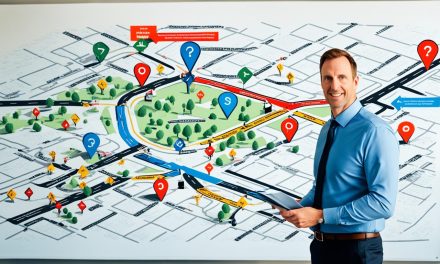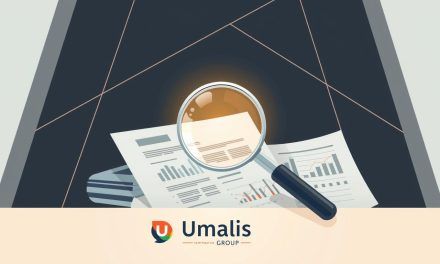We remember a Parisian consultant who nervously signed a plan that promised fast change. Within weeks, teams felt overwhelmed and priorities drifted. That early misstep taught a simple lesson: bold intent needs clear guardrails.
Today, we guide you to move from intent to measurable outcomes without sacrificing trust. Our approach balances opportunity and risk so your company protects revenue and reputation while improving customer value.
The guide explains how digital and transformation reshape business models, operations, and experience. It goes beyond tools to cultural change, governance, and leadership alignment that keep momentum.
With practical frameworks and security by design, you will learn how to choose the right technology, set delivery rhythms, and communicate change to stakeholders. This helps reduce risk and accelerate time-to-value in a shifting market.
Table of Contents
Key Takeaways
- Balance opportunity and risk with a secure, structured plan.
- Focus on culture and leadership to sustain long-term change.
- Link investments to customer experience and measurable value.
- Integrate security from day one to protect brand and revenue.
- Use clear governance and delivery rhythms to speed time-to-value.
Defining the Digital Age: From Digitization to Digital Transformation
Businesses often confuse simple data conversion with a full-scale reinvention of how work gets done. We separate three clear stages so you can choose the right scope and outcomes.
Digitization: Turning Analog Records into Digital Files
Digitization is the technical step of converting paper records to electronic files. It improves access and reduces storage costs.
Digitalization: Making Existing Processes Faster and More Efficient
Digitalization uses that converted data to speed up routine activities. For example, retrieving customer records in seconds streamlines service without changing the core process.
Digital Transformation: Rethinking Business Models, Culture, and Customer Value
True transformation reframes business processes and experience to unlock new revenue and value propositions. Netflix is a practical example: it used data to shape personalized products and even to fund original content.
- Aim outcomes first: avoid tech-first traps and align technology to a clear problem.
- Choose scope wisely: optimize existing processes or redesign them for step changes in cost, speed, or experience.
- Use learning loops: pilots, measurement, and scaling reduce risk and build confidence.
Why Digital Transformation Matters Right Now
The last few years rewired customer expectations and exposed operational fragility across sectors. Markets moved fast: streaming and home fitness habits stuck, online grocery grew, and B2B selling shifted to remote models.
These trends mean your business cannot wait for perfect plans. You must experiment, learn, and scale quickly. CIOs balance innovation with stable operations while boosting resilience so customers see no disruption.
Resilience now measures how well an organization pivots when supply, demand, or rules change. Automation, richer data, and better digital channels cut fragility and speed decisions under pressure.
Practical steps matter. Focus on near-term wins that protect revenue and build trust. Improve employee experience of tools to keep remote teams productive. Be honest about budget and talent limits, then pick pilots that deliver measurable value.
- Checklist: customer churn, margin squeeze, compliance dates, aging systems.
- Quick wins: automate a manual process, improve remote sales tooling, expose data for faster decisions.
Act now to secure options for the future. Small, well-paced change wins credibility and keeps your organization positioned as market trends continue to evolve.
Pillars and Frameworks That Guide Successful Transformation
Successful change rests on a small set of pillars that align purpose, people, and measurable outcomes. These pillars help you focus investment and reduce risk while delivering clear value.
Customer experience becomes the North Star. Map journeys, pick a few outcome metrics, and link them to end-to-end processes so teams can see how work affects users.
Operational agility follows. Simplify steps, add automation where it cuts cycle time, and create feedback loops that let you learn fast and scale wins.
Culture and leadership sit at the core. Define the sponsor role, staff change champions, and set incentives so adoption outpaces rollout.
Enterprise technology integration breaks silos. Prioritize interoperable platforms, clear data ownership, and guardrails to avoid shadow IT.
- Translate pillars into testable value hypotheses and measurable goals.
- Stage capability building so teams sustain and scale improvements.
- Use governance and funding to ensure accountability and predictable delivery.
| Framework | Primary focus | Best for | Practical tip |
|---|---|---|---|
| MIT Sloan | Strategy & metrics | Large enterprises | Start with value hypotheses and KPIs |
| Cognizant | Execution & scaling | Complex programs | Pilot fast, then industrialize |
| Prophet | Customer-led design | Customer-centric firms | Map journeys to funding requests |
| Ionology | Operational model | Midsize adopters | Align operating model and governance early |
For practical next steps, consult our framework guidance to adapt these pillars to your sector and maturity.
Culture, Leadership, and the Human Side of Change
Trust built through steady empathy makes large-scale programs practical and durable. Leaders must show they understand daily work and fears to reduce resistance. That starts with consistent listening and visible actions.
Empathy, Trust, and Change Management in Cross-Functional Teams
Empathy-driven leadership earns credibility. Start with small, team-level rituals: demos, retrospectives, and story-sharing that make progress tangible.
Use clear role definitions and feedback loops so cross-functional work is predictable and fair. Coach middle managers to translate strategy into daily practices.
Engaging Old-Timers, By-the-Book Players, and Lone Wolves
Segment your approach. Meet each group where they are:
- Old-timers: honor experience; create mentoring roles that value institutional knowledge.
- By-the-book players: give clear processes and checklists to reduce anxiety.
- Lone wolves: offer targeted goals and recognition that link autonomy to team outcomes.
We provide templates for communication plans, incentive mapping, and leading indicators to spot fatigue early. These tools help you protect employee well-being while pushing for results.
For practical guidance on organizational change and expert coaching, see our expert change support. This helps you sustain culture and keep teams aligned on purpose.
The Modern Tech Stack: Cloud, AI/ML, and Data Analytics
Today’s platforms let you scale capacity, automate decisions, and turn streams of data into action. We focus on practical choices that reduce cost and speed delivery while protecting operations.
Cloud as an Innovation Driver and Agility Foundation
Cloud enables on‑demand scaling, lower fixed costs, and resilient, global collaboration. Use containers, serverless, and managed services to simplify ops and raise reliability.
Artificial Intelligence and Machine Learning for Insights and Automation
Artificial intelligence and machine learning power chatbots, fraud detection, predictive maintenance, and personalization. Pilot with explainability, bias checks, and human review.
Big Data and Analytics for Data-Driven Decisions
Data platforms and analytics turn raw signals into decisions. Prioritize governance, quality, and compliance so reports and models stay reliable across teams.
IoT and Connected Systems to Extend Capabilities
Connected systems extend visibility from field devices to back office. This adds real‑time controls and new service capabilities while reducing silos.
- Match workloads to the right cloud services for cost, performance, and compliance.
- Modernize with containers and serverless to lower operational burden.
- Decide build vs buy based on scale, timeline, and in‑house skills.
These technologies guide a measured transformation path that balances speed, security, and measurable value for your teams.
Security by Design: Building Trust into Your Transformation

Security must be an active design choice, not an afterthought, when you modernize systems and services. We help you balance speed and risk so your company moves with confidence.
Governance, risk, and zero‑trust form the backbone of a resilient program. Establish clear roles so risk, compliance, and delivery teams make faster, safer decisions.
Governance, Risk, and Zero-Trust Architectures
Adopt zero‑trust principles—verify explicitly, apply least‑privilege, and assume breach. Use policy-as-code and automated checks to keep developer velocity high while enforcing guardrails.
Privacy, Compliance, and Resilience from Day One
Operationalize privacy-by-design to avoid rework and fines. Build incident readiness with tabletop exercises, runbooks, and defined recovery objectives.
- Controls: identity, secrets, encryption, and observability that scale with your services.
- Cloud clarity: map shared responsibility so teams know what the company owns across people, process, and technologies.
- Pipeline safety: integrate security testing so quality and safety move together.
« A secure design does more than reduce risk — it earns trust and speeds adoption. »
For practical support on governance and secure delivery, explore our professional services. We guide you from policy to practical controls so the program protects users and business value.
Customer and Employee Experience in a Digital-First World
Customers now expect relevance at every touchpoint, not just fast answers. Personalization must be driven by clean data and clear journey orchestration so each interaction feels purposeful.
Personalization and Journey Orchestration
Use behavior and profile signals to adapt offers and messages in real time. Start with a few high-value journeys and measure lift before scaling.
Omnichannel Service and Social Support
Design service so customers find consistent answers across web, app, phone, and social. Integrate community and social support to reduce friction and accelerate buying decisions.
Digital Workplace: Collaboration, Mobility, and Enablement
Employees must have fast access to context and tools. Empower teams with mobile access, unified knowledge, and secure identity so service stays responsive from any location.
- Connect marketing, sales, and service to keep history and context flowing.
- Balance automation with human touch to keep empathy in service.
- Measure NPS, CES, and employee satisfaction and close the loop with feedback.
« Personal relevance and employee enablement are the twin engines of loyalty. »
Operating Models, Processes, and Automation
Operating models and automated processes decide how fast your organization can turn ideas into customer value. Legacy systems often consume 70–80% of IT budgets and block agility. Modernizing that estate frees capacity for innovation and analytics.
Agile Ways of Working and Continuous Delivery
We define clear roles, funding lines, and outcome-based teams so work flows without friction. Agile methods and continuous delivery shorten cycle times and raise reliability.
Use lightweight governance, automated testing, versioning, and observability to keep quality high while moving fast. Platform teams deliver reusable capabilities so product teams focus on customer outcomes.
Legacy Modernization to Unlock Velocity and Value
Prioritize business processes for automation where they create measurable value and reduce errors. Decide to refactor, replatform, or replace based on risk, cost, and impact.
- Practical steps: progressive delivery, rollback plans, and staged cutovers to lower risk.
- Recommended practices: choose tools and software practices that embed testing and monitoring.
« Convert technical debt into momentum by balancing investment with clear impact. »
Measuring ROI and Business Value of Transformation
Measuring results means linking each initiative to a clear financial or customer outcome, not just technical milestones. This keeps conversations with finance and the board focused and credible.
We define core value drivers and show how to quantify them so you can defend investments and secure funding.
Value Drivers: Revenue, Efficiency, and Experience
Start by mapping where change creates value:
- Revenue: conversion lift, new product pricing, and cross-sell impact.
- Efficiency: reduced cycle time, headcount shifts, and lower operating costs.
- Experience: retention, Net Promoter Score, and support cost per user.
- Risk reduction: fewer incidents, faster recovery, and compliance avoidance.
KPIs, Benchmarks, and Time-to-Value
Choose KPIs that tie directly to the business goal and are measurable early and often.
- Use analytics and data models to generate actionable insights for prioritization.
- Set realistic time-to-value windows and benchmark against market peers.
- Apply baselines, counterfactuals, and confidence intervals to separate signal from noise.
Our method pairs leading indicators with lagging outcomes and a benefits realization plan. Establish review cadences so you can course-correct without derailing delivery.
« A clear value story turns effort into funding and keeps momentum across the organization. »
For practical templates and guidance on presenting ROI narratives to finance and the market, see our marketing strategy resources. They include baselines, attribution methods, and review cadences you can adapt to your program.
digital transformation
Begin with a concise « why » that ties change to measurable customer, efficiency, or profit goals.
We help you define scope tightly so work stays focused and budgets are spent on clear outcomes.
Scope is more than a project list. It is a guarded boundary that prevents diffuse efforts and wasted investment.
Clarifying Scope, Outcomes, and Stakeholder Alignment
Align outcomes to your why: link customer experience, productivity gains, or profitability to specific initiatives.
- Stakeholder maps: show owners, decision rights, and escalation paths so teams act with clarity.
- Guardrails: set metrics and constraints that permit safe experiments while keeping strategy intact.
- Capacity sequencing: balance ambition with team load to avoid burnout and delivery delays.
Make culture an explicit plan item. Treat adoption as a design objective with clear incentives, roles, and feedback loops.
We provide a charter template that captures scope, outcomes, metrics, risks, and owners. Refresh scope as learning accumulates but keep the core why unchanged.
« Clear scope and aligned stakeholders reduce friction and accelerate delivery. »
Your Step-by-Step Roadmap to a Secure Digital Transformation
A clear roadmap starts with a compact, repeatable goal that links fast wins to long-term value. This rallying point guides choices about scope, funding, and risk.
Set the vision and define the “why”
Pin a measurable outcome and a realistic time horizon. We help you craft a why that unites teams and frames trade-offs.
Assess capabilities and technical debt
Inventory systems, processes, and people. Score technical debt by risk and cost so you can sequence fixes and avoid surprise spend.
Prioritize use cases and build the business case
Rank initiatives by value, feasibility, and compliance. Use small business cases to secure funding for pilots rather than large, risky bets.
Deliver in iterations: pilot, learn, and scale
Ship working software early. Pilot, measure, and expand the winners to shorten time to results and reduce rework.
Establish governance, security, and operating rhythm
Unite product, security, and operations with clear roles, policies, and a steady cadence of reviews. Integrate security into pipelines from day one.
- Sequence technologies and tools to limit dependencies.
- Use feedback loops from customers and staff to refine scope.
- Adopt roadmap templates and staffing plans tied to milestones.
« A pragmatic, iterative roadmap reduces risk while accelerating benefits. »
Real-World Examples and Use Cases

Concrete use cases help teams move from theory to repeatable steps that deliver measurable value.
Netflix: Data-Driven Experiences and New Business Models
Netflix is a clear example of using viewing data to change products and business models.
They shifted from mail-order to streaming and then to in‑house production. Viewing signals inform personalization and content investment.
B2B Growth: Remote Selling, CRM, and AI Insights
Remote selling scales when CRM discipline is paired with artificial intelligence for lead scoring and next-best actions.
These insights help sellers focus on deals that matter and improve conversion for customers in varied markets.
Public Sector: Cloud-Enabled Service Modernization
Public agencies use cloud to modernize services, improve access, and raise resilience beyond simple cost savings.
Governance and data sovereignty matter; start with a pilot that proves access and compliance before broad rollout.
- Patterns: personalization, subscription economics, and continuous experimentation.
- Capabilities: data platforms, agile delivery, and an experimentation culture.
- Start small: pilots that validate value and respect local constraints.
| Example | Primary focus | Key capability | Starter pilot |
|---|---|---|---|
| Netflix | Customer personalization | Streaming data platform | Personalized recommendations pilot |
| B2B sellers | Revenue growth | CRM + AI insights | Lead scoring test |
| Public sector | Service access & resilience | Trusted cloud and governance | Single-service cloud migration |
« Focus on principles, not blind copying; adapt tactics to your constraints. »
Takeaway: study these examples for patterns, then design pilots that fit your budget, risk profile, and regulatory needs. We guide you to replicate success with clear guardrails.
France and EMEA Considerations: Regulations, Cloud, and Culture
Regulatory expectations across France and EMEA shape how companies design cloud architectures and run services.
Privacy and residency rules mean your architecture must map data location to lawful bases and contractual safeguards.
Data Sovereignty, GDPR, and Trusted Cloud Choices
Start by mapping what personal data you hold and where it flows. Then choose trusted cloud providers with residency options, EU certifications, strong encryption, and clear contracts.
Practical controls include encryption-at-rest, processor agreements, and documented lawful bases for cross-border transfers.
Market Nuances: Language, Local Expectations, and Ecosystems
Local language and partner ecosystems shape adoption. Use regional partners for localization, support, and procurement navigation.
- Balance centralized standards with local adaptations to preserve consistency across the market.
- Phase changes to meet compliance timelines while keeping customer-facing services reliable.
- Engage regulators and industry groups early to anticipate policy shifts.
| Area | Key concern | Recommended action |
|---|---|---|
| Data residency | Cross-border transfers | Local hosting + SCCs or adequacy mechanisms |
| Procurement | Vendor risk | Due diligence, certifications, and contract clauses |
| Adoption | Local trust | Partner-led services and localized UX |
« Compliance is not a brake; it is a framework that lets your organization move faster with trust. »
Choosing the Right Transformation Partner
Partner selection is a strategic move. CEOs expect IT to drive innovation and revenue, so your external ally must do more than deliver projects.
Evaluation Criteria: Security, Industry Expertise, and Platforms
Start with clear criteria that align to your risk profile and sector needs.
- Security: verify practices, audits, and incident readiness.
- Industry expertise: look for proven case studies in France and EMEA.
- Platform strategy: check portability to avoid lock-in while gaining advantage.
Co-Innovation and Long-Term Capability Building
Choose a partner that transfers skills to your teams through joint sprints, POCs, and coaching.
We favour commercial models that reward outcomes and knowledge transfer, not just billable hours.
- Test claims with short proofs-of-concept that show services, solutions, and real risk management.
- Use scorecards and reference questions to compare offers objectively.
« A partner should amplify your business and leave you more capable than before. »
Conclusion
Lasting progress comes from tightly linked goals, short learning cycles, and honest measures of value.
We reaffirm that digital transformation is a continuous journey that blends strategy, culture, and secure technologies. Treat the change program as ongoing work, not a single project.
You are equipped with clear recommendations to act now, sequence initiatives, and protect customers’ trust. Keep customers centered and align products services and experience to measurable outcomes.
Adopt new technologies only where they add advantage. Strengthen intelligence in decision‑making so data becomes action, and invest in learning to adapt to market trends.
Review your roadmap quarterly, build leadership capability, and co‑innovate with a partner who transfers skills. Lead with clarity and care to secure lasting growth.
FAQ
What is the difference between digitization, digitalization, and digital transformation?
Digitization converts analog information into digital files. Digitalization uses those files to make processes faster and more efficient. Digital transformation is broader: it reshapes business models, culture, customer value, and operating processes by combining new technologies, data, and organizational change.
Why should my company prioritize this change now?
Market expectations, competitive pressure, and faster innovation cycles require organizations to adapt. Prioritizing this change improves customer experience, operational agility, and resilience while unlocking new revenue and efficiency through cloud, AI, and analytics.
What are the foundational pillars for a successful program?
Success rests on four pillars: a clear customer experience strategy, operational agility and process reinvention, strong culture and leadership, and integrated technologies (cloud, AI/ML, analytics). Governance and security must be embedded from the start.
How do we manage the human side of change?
Start with empathy and clear communication. Build trust with cross-functional teams, provide targeted learning and enablement, and involve managers as change sponsors. Address concerns of long-tenured staff through tailored coaching and early wins.
Which technologies should we prioritize in our stack?
Focus on cloud as the agility foundation, AI and machine learning for automation and insights, and analytics for data-driven decisions. Consider IoT where device data extends capabilities. Prioritize technologies that map directly to business outcomes.
How do we ensure security and privacy during the journey?
Adopt security by design: enforce governance, risk management, and zero‑trust principles. Embed privacy and compliance (GDPR, local rules) early, run resilience testing, and maintain strong identity and access controls across systems.
How can we improve both customer and employee experiences?
Use personalization and journey orchestration to boost customer value. For employees, enable collaboration through modern workplace tools, mobility, and self-service. Measure satisfaction, reduce friction, and connect front-line feedback to product and service teams.
What operating model changes deliver the most value?
Shift to agile ways of working and continuous delivery to shorten time-to-value. Modernize legacy systems to remove technical debt and unlock velocity. Introduce clear operating rhythms and cross-functional squads to sustain momentum.
How do we measure ROI and business value?
Track value drivers like revenue growth, cost efficiency, and experience improvements. Define KPIs and benchmarks—conversion rates, cycle times, uptime, and time-to-market—and measure outcomes per iteration to validate investments.
How should we define scope and align stakeholders?
Clarify the expected outcomes and success metrics up front. Map stakeholders, their pain points, and decision rights. Use prioritized use cases and a business case to secure sponsorship and funding.
What does a practical roadmap look like?
A pragmatic roadmap sets vision and why, assesses capabilities and technical debt, prioritizes high-impact use cases, and delivers in iterations (pilot, learn, scale). Establish governance, security, and an operating rhythm to sustain progress.
Can you give real examples of successful initiatives?
Examples include Netflix using data to personalize experiences and invent business models; B2B companies adopting remote selling, CRM, and AI insights to grow; and public sector organizations modernizing services through cloud to improve citizen outcomes.
Are there regional considerations for France and EMEA?
Yes. Pay attention to data sovereignty, GDPR compliance, and trusted cloud options. Local market nuances—language, regulatory expectations, and ecosystem partners—should shape your approach and partner selection.
How do we choose the right partner for our journey?
Evaluate partners on security posture, sector expertise, proven platforms, and ability to co-innovate. Prioritize those who build long-term capabilities within your teams and offer measurable outcomes and references.





